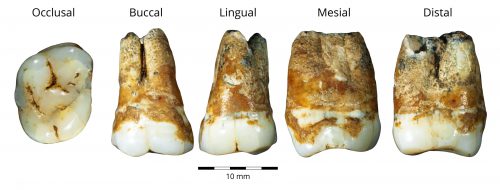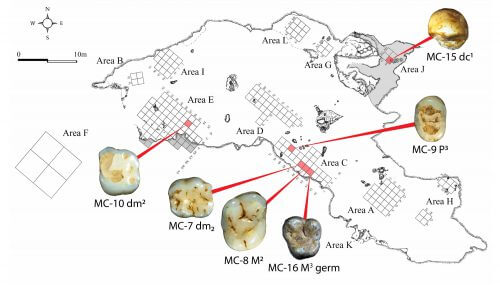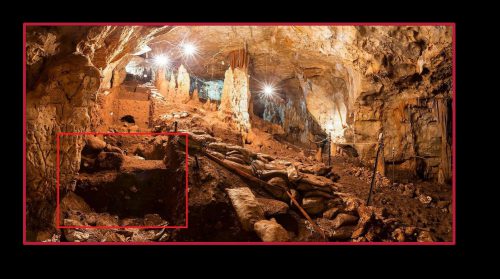The findings support that at that time humans migrated from Europe to the Land of Israel and opened a new era in the cultural development of our region * The article was recently published in the Journal of Human Evolution


In the research of Dr. Racheli Sharig, a researcher from the School of Dentistry and the Dan David Center for the Study of Human History of the Sackler Faculty of Medicine, in collaboration with Dr. Omri Barzilai, Head of Research and Archeology Specialties at the Antiquities Authority, six human teeth were found in Menot Cave in the Western Galilee. The researchers determined with the help of dental research that they belong to the modern man and the Neanderthal man. The teeth were found in the layers belonging to the Orania culture that originated in Europe, and are the first anthropological evidence of a human population that migrated from Europe to the Land of Israel about 40,000 years ago.
Menot Cave has been studied over the past decade by Dr. Barzilai from the Antiquities Authority, Prof. Israel Hershkowitz from the Dan David Center at Tel Aviv University, and Prof. Ofer Marder from Ben-Gurion University in the Negev, with the aim of tracing the development of modern man in the Land of Israel. The article was recently published in the Journal of Human Evolution.
"During a prehistoric excavation in Menot Cave in the Galilee, we recently found 6 human teeth, a find that is of great importance for identifying the inhabitants of the cave tens of thousands of years ago," explains Dr. Sharig. "Teeth are preserved better than bones because they are made of enamel, the most durable material in the body. More importantly: the structure, shape and topography (protrusions on the surface) of the tooth have a strong genetic component, which allows teeth to be associated with specific populations. In the current study, we were based on the external and internal shape of the teeth to characterize and associate them. In four of the teeth, we performed in-depth tests in the laboratory: micro-CT scans and XNUMXD analyses."
Neanderthal man assimilated into modern man
The results obtained surprised the researchers: one tooth showed a typical morphology of the Homo sapiens species - the modern man; One tooth showed features typical of Neanderthal man; And two teeth showed a rare combination of Neanderthal and modern features. The researchers point out that such a combination is found to date only in European populations from the beginning of the Upper Paleolithic period, about 40,000 years ago. Recently, the combination was also proven genetically, and it implies that the Neanderthal man assimilated into the modern man in Europe.
"The teeth from Manot Cave are of crucial importance because until today we had no human remains from that period in the Land of Israel, and there is a significant time gap in our knowledge," notes Prof. Hershkowitz. "The groundbreaking research brings for the first time the story of a population responsible for one of the most important cultural revolutions in human history."

Dr. Barzilai explains: "The teeth were found in archaeological layers associated with the Orania culture, a rich and developed culture that is associated with the end of the Neanderthal era in Europe, and symbolizes a new era in the cultural development of modern man. Based on new genetic studies that showed that the Neanderthals in Eastern Europe were assimilated into the local Orania population, we tend to interpret the presence of Neanderthal traits in two of the dishes as further evidence that the origin of the Orania culture in the Eastern Mediterranean region is from Europe. It is possible that these populations sought to distance themselves from the extreme climatic conditions that prevailed in their countries of origin at the time - the peak of the last ice age."
"Our findings are particularly important because they shed light on a relatively unknown period in human history in the Land of Israel," concludes Dr. Sharig. "Nowadays it is assumed that the Neanderthals disappeared from the Levant about 50 thousand years ago with the arrival of modern human populations from Africa. The finding of Homo sapiens and Neanderthal characteristics in teeth from 38 years ago in Menot Cave supports the hypothesis that the population that migrated here, most likely from Europe, was mixed and may have brought their culture with them at that time. In this way, our research provides another point in time in the evolutionary and cultural sequence, another piece of information in the huge puzzle called human history."


2 תגובות
lion heart,
Questions:
1. Where is the information about a gap of 30 points in the IQ between the European mixed race and the Homo sapiens south of the Sahara?
2. The stronger admixture is found in Europe, and according to you the phenomenon of genetic enrichment leading to an increase in IQ should probably be found first and to a greater extent in Europe, and less so in the Middle East and North Africa (even today the proportion of genes of Neanderthal origin is higher in the European population than in the Middle Eastern population ). If so, how did it happen that it was in the Mazat in general, and in Sumer, Babylon, Assyria, Palestine and Egypt in particular - that the cultural achievements were achieved in the area of settlements - permanent settlements, agriculture and urbanization, and especially the great intellectual achievements of the writing culture from 5100 years ago onwards - and not in Europe, which was In all the periods they are quite retarded?
3. The proportion of genes of Neanderthal origin is higher among the populations of the Far East and certain areas of South Asia and among the natives of the islands in the Indian Ocean and Australia compared to their proportion among the populations of Europe and the Middle East. In the aforementioned populations there is also another specific genetic imprint - Denisovan, and possibly also of a fourth human species. Under these conditions, it was expected that the genetic enrichment would occur and it would create a higher average IQ and, in general, a stronger civilization in those places compared to the Middle East and Europe. It did not happen. How do you explain that, in your opinion?
It is not clear to me why a person who came up north from Africa is called a "modern man" when the modern man in the correct sense is the mixture of the African and the Neanderthal. In sub-Saharan Africa there is a "modern man" population that did not migrate north and did not meet or assimilate with the Neanderthals, and they are not modern at all in the conventional sense of the word. The mixture with the Neanderthal created an IQ, one that is common among humans in Europe, 100 points, while the "modern" man south of the Sahara lags behind by about 30 points. So please remember that such a "modern man" found in Europe and not in South Africa, is the product of hybridization with Neanderthals.
There is a misunderstanding regarding the essence of the Neanderthal man, as clumsy in his body and intellect. I read about a year ago about a new carbon test of the wonderful cave paintings in the caves in Spain, and in the article it was written that they are about 65.000 years old, that is - they were painted 30.000 years before the arrival of "modern man" from Africa to Europe. Wonderful and wonderful Neanderthal work. Among the Neanderthal remains in Europe is also a flute, a tube with holes, like the bagpipe, and it is built on a 7-tone scale, - like the basic "Doric" scale in our music.
So…. It is imperative to change the common image of the Neanderthal as primitive, especially among all those with bright eyes and red hair. These are Neanderthal gifts.